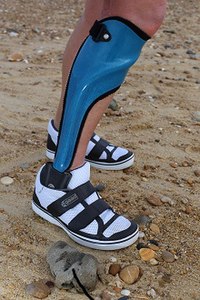
Photo from wikipedia
Purpose: The purpose of this study was to compare the outcome of combined circular external fixation and cemented polymethylmethacrylate (PMMA) spacer application between a cohort of patients with grade 3… Click to show full abstract
Purpose: The purpose of this study was to compare the outcome of combined circular external fixation and cemented polymethylmethacrylate (PMMA) spacer application between a cohort of patients with grade 3 open fractures and infected tibial nonunions and concomitant segmental bone loss. Methods: The study was designed as a retrospective cohort study. All patients who were treated for complex tibial fractures or infected nonunions with segmental bone loss between 2009 and 2013 were included if they were aged between 16 years and 60 years, sustained acute traumatic grade 3 open tibial fractures, presented with infected nonunion, and were followed up for a minimum of 12 months. Patients with a history of ipsilateral tibial fractures, contralateral lower extremity fractures, polytrauma, chest, or abdominal trauma and patients with head injuries were excluded. Both groups were treated with aggressive debridement, circular external fixation, and antibiotic-impregnated PMMA spacer. Outcome measures were the time in the external fixator (EFT) and the external fixation index (EFI). Results: Twenty-four patients with a mean age of 32 ± 14.7 years were included. Twelve patients with a mean age of 32 + 14 years and a mean bone defect of 82 + 36 mm were treated for acute complex grade 3 open tibial fractures, and 12 patients with a mean age of 35.1 + 15.7 years and a mean bone defect of 50 + 26 mm were treated for infected nonunions. There was no significant difference (p = 0.44) between the groups for EFT (249 ± 99 days—tibial fractures; 255 ± 142 days—infected nonunion). There were significant between group differences (p = 0.027) for EFI (37.3 ± 9.1 cm/days—tibial fractures; 56 ± 14.5 cm/days—infected nonunion). Conclusion: The findings of this study suggest that patients were treated for infected nonunion with segmental bone loss using circular external fixation, distraction osteogenesis, and antibiotic-impregnated PMMA spacers, and the spacers may not offer any advantage over a conventional approach using the principles of osteogenesis only. In contrast, antibiotic-impregnated spacers for open tibial trauma were advantageous and reduced the EFI considerably.
Journal Title: Journal of Orthopaedic Surgery
Year Published: 2017
Link to full text (if available)
Share on Social Media: Sign Up to like & get
recommendations!